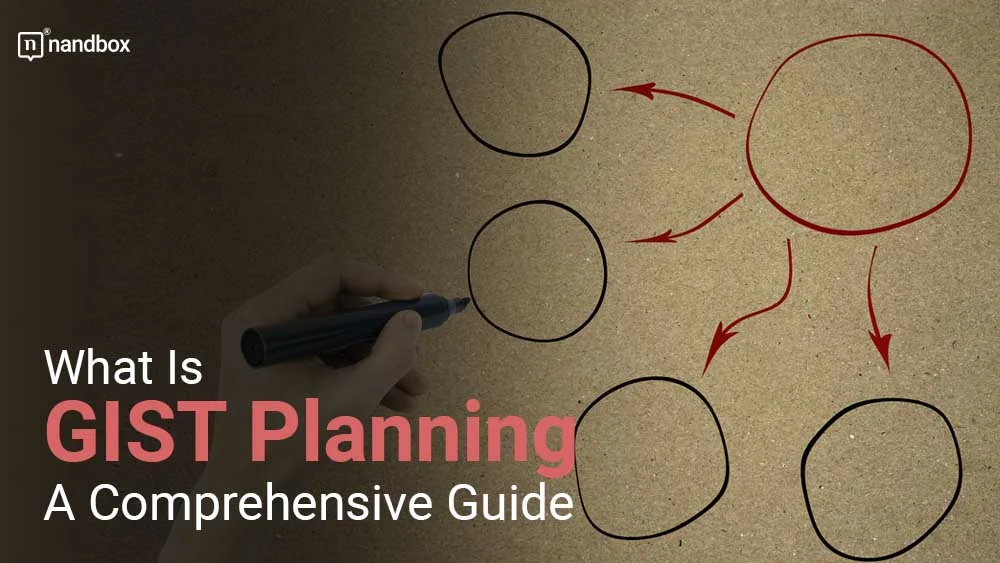Priorities and speed are sometimes the most important things we look for when planning something. The word GIST itself stands for “Goals, Ideas, Step projects, and Tasks.”
GIST planning is a structured and organized method of goal setting used to establish objectives and work towards them. It provides structure and guidance for setting concrete goals and developing actionable plans that help you make progress toward them. You’ll also be able to track your progress easily, making it easier to stay motivated while achieving your ultimate goals. GIST planning is a lean method of product planning. With the aim of lowering management overhead, boosting velocity, and creating products that better fit the market’s needs.
GIST is designed to only develop solutions and products with the organization’s goals in mind. Itamar Gilad created GIST while he was working at Google. Along the way, he used ideas from the Lean and Agile methods and approaches.
What Is the GIST Planning Process?
The steps of the GIST planning process have to be done in a certain order. By doing this, rather than retroactively classifying a single activity into a certain piece of the larger plan, everything starts with a goal and ends with a specific item that helps to accomplish that specific goal. How do I prepare for the GIST planning process? It’s easy. Before beginning the GIST planning process, it’s important to set aside some time and clear your schedule so you can dedicate yourself to it.
Take some time to write down any expectations you have for yourself. In addition to any long-term goals that come to mind. Also, make a list of short-term objectives. Then, create measurable tasks that relate directly to each goal or objective. This will help your plans become more realistic and achievable. Let’s break down the word “GIST” and make sure we cover everything behind this product management method.
Goals
The company’s top-level goals are its goals, which are also the reason for everything it does. They might change over time, but for the most part, they stay the same. They are considered a key part of the business strategy as a whole. Any worthwhile objective is quantifiable. The majority of objectives are substantial enough to take a long time to accomplish. Due to their different importance and timing, their deadlines and goals for completion are sometimes spread out. Setting goals can last for several years and is often done annually. Yet they should be frequently reevaluated to make sure they remain relevant.
Ideas
After the goals have been set, the teams must now decide on possible ways to reach them. This stage of the process is an “anything goes” one since numerous ideas will be taken into account as potential ways to achieve the desired goals.
All concepts continue to be strong candidates for eventual implementation. Ideas exist in an “Idea Bank,” waiting to be retrieved and investigated until they are actively being developed.
Teams can use one of the various scoring methods for prioritization to identify which ideas should be worked on first (such as RICE, ICE, Opportunity, Weighted, and KANO). Even though the ideas will be put in order as a result of this prioritization, GIST planning hasn’t picked a winner yet. It serves as a guide for choosing which concepts should be put to the test initially.
After figuring out what their goals are, many teams have an initial brainstorming session to come up with ideas. Any time ideas are developed, they can be added to the Idea Bank for review and prioritization in the future.
Step Projects
The idea behind step projects is that businesses often have ideas they think will make a big difference. Then, with that confidence and momentum, these huge projects have so much inertia that they aren’t often evaluated for rationality during the implementation phase, and their effectiveness isn’t evaluated until a lot of time and resources have been put into them.
Step-projects reduce ideas into a number of smaller experiments with a maximum limited time frame of 10 weeks, borrowing from the MVP philosophy.
Each step-project is thoroughly assessed many times. Beta testing, early usability testing, and reviews are all looked at to see how useful they are for developing step-projects in the future.
For this approach to be effective, each step-project needs to have definite, quantifiable goals. That is to show whether the business is on the right track for the overall concept. Instead of spending more money on that specific idea if the outcomes of the step-project don’t work out, go back to the idea bank and choose an alternative strategy to achieve the objectives of the product. When businesses “fail fast,” they can drop bad ideas sooner and devote their resources in a different direction.
Tasks
The most specific level of the GIST process is a task. People who are used to the Agile methodology or approach will know that well. In this case, the tasks for step-projects are product features and improvements that have been broken up into smaller pieces so that members of the product development team can pick them up and finish them as quickly as possible.
Steps of the GIST Planning Process
Here are some steps to follow in order to get the process right and allow your app or business to benefit from it as it should.
Analyzing the Situation at Hand
After you’ve identified and listed your expectations, goals, and objectives, it’s important to take a step back and consider the situation at hand. Ask yourself questions such as “Is this realistic?” How can I achieve each goal or objective? What resources do I have available to me? You’ll be better able to make a plan of action once you’ve answered these questions and gathered as much information as you can.
Strategizing for Genuine Opportunities and Threats
As part of GIST Planning, it’s key to evaluate any genuine opportunities and threats that your decisions could present. In order to identify and explore any new possibilities, it’s essential to research the situation thoroughly and make sure that there are feasible solutions. That way, you can be sure that you are making an informed decision and ensure its success by preparing yourself for any issues that may arise.
Defining Objectives and Outcomes of the Plan
It is essential to establish clear objectives and outcomes in GIST Planning. The criteria outlined should ensure that the action will be achievable and effective, providing measurable success in the long run. To do this, it’s best to brainstorm ideas with employees or colleagues through discussion and then identify which goals should remain key objectives. This way, all stakeholders can provide input and help keep the team on track with any actions taken.
Advantages of GIST Planning
Everything has its pros and cons, and although the concept that underlies GIST planning isn’t groundbreaking, it still has certain advantages that we will cover below.
- Prioritization of ideas: It makes little sense to put off a good idea for months or years. That is only because good ideas don’t follow a schedule. GIST frees organizations from arbitrary cut-offs for new concepts. Moreover, it makes them more open to experimenting with novel ideas that weren’t previously on the table. If another idea receives a higher score, it will be given priority over it, rather than having to wait months or years for its turn.
- Continuance of evaluation: GIST fosters a culture of ongoing criticism rather than becoming entangled and committed to lengthy initiatives with little knowledge of their ultimate value. Losers can be discarded in favor of trying something different by regularly monitoring an idea’s effectiveness. When every concept is up for debate, no one’s ego is injured, and no one gets their feelings hurt.
- A method that is driven by goals: Every initiative at GIST is built on the premise that it will advance a corporate objective. By doing this, projects that are in line with long-term goals receive a shift in the allocation of resources.
Disadvantages of GIST Planning
- Short-term planning method: When GIST planning is fully implemented, companies don’t commit to anything more detailed than short-term goals. While this enables a company to be incredibly fluid and dynamic, it hinders the company’s capacity to work on bigger projects that require numerous phases and take a lot longer. They could be consumer promises, technological advancements, or linkages of enterprise systems.
- Impedes capacity or futuristic planning: It is challenging to put plans in place to support activities when an organization is uncertain about the future. A GIST planning environment sacrifices having a strong grasp of what is on the horizon.
Final thoughts
With nandbox, all you need to plan is the feel and look of your app. You plan and come to us to implement. Our native no-code app builder simply allows you to create and choose everything in your app from scratch. You can implement GIST planning through your product management campaign after deciding on your app idea. Our app builder can help you create an app that is flawless when it comes to the features and modules included in it. nandbox’s simple drag-and-drop feature will help facilitate your development process and help you create an app within a very short period of time.
Sign up now for our app builder and benefit from our 14-day free trial. The GIST planning method and ideas don’t prevent using a suitable product roadmap; however, in some businesses, using GIST planning as an entry to the road mapping approach may be successful. Agile and road mapping can coexist, despite the objections of some.






